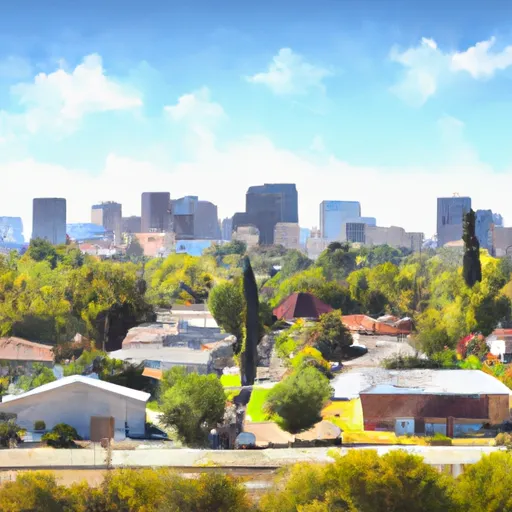-
 Snoflo Premium
Snoflo Premium
Get unlimited access to all our content
With no Ad interruptions! - Start Your Free Trial Login with existing account
Ivanhoe
Eden Index
Climate
8.5
•
Recreation
3.6
•
Community
2.3
•
Safeguard
5.3/10

Ivanhoe, California is a small unincorporated community located in Tulare County. Known for its pleasant climate, Ivanhoe experiences hot, dry summers and mild winters. Summers usually see temperatures reaching highs in the mid-90s Fahrenheit, while winters average in the mid-50s. The area receives minimal rainfall, with most precipitation occurring during the winter months.
Ivanhoe benefits from its proximity to the Kaweah River, which flows through the community. The river provides hydrological support to the region, ensuring a steady water supply for irrigation and agricultural purposes. Additionally, the groundwater in Ivanhoe is sourced from wells and plays a vital role in sustaining the local agricultural activities.
While Ivanhoe itself does not have specific outdoor recreation opportunities, its close proximity to Sequoia National Park and Kings Canyon National Park offers residents and visitors a plethora of natural wonders to explore. Within these parks, outdoor enthusiasts can indulge in activities like hiking, camping, fishing, and wildlife observation. With their stunning landscapes, these nearby destinations provide ample opportunities for outdoor adventure and relaxation.
What is the Eden Index?
The Snoflo Eden Index serves as a comprehensive rating system for regions, evaluating their desirability through a holistic assessment of climate health, outdoor recreation opportunities, and natural disaster risk, acknowledging the profound impact of these factors on livability and well-being.
Climate Health Indicator (CHI): 8.5
Ivanhoe receives approximately
304mm of rain per year,
with humidity levels near 36%
and air temperatures averaging around
18°C.
Ivanhoe has a plant hardyness factor of
9, meaning
plants and agriculture in this region tend to thrive here all year round.
By considering the ideal temperature range, reliable water supplies, clean air, and stable seasonal rain or snowpacks, the Climate Health Indicator (CHI) underscores the significance of a healthy climate as the foundation for quality living.
A healthy climate is paramount for ensuring a high quality of life and livability in a region, fostering both physical well-being and environmental harmony. This can be characterized by ideal temperatures, reliable access to water supplies, clean air, and consistent seasonal rain or snowpacks.
Weather Forecast
Streamflow Conditions
Tulare-Buena Vista Lakes
Area Rivers
Tulare-Buena Vista Lakes
Snowpack Depths
Tulare-Buena Vista Lakes
Reservoir Storage Capacity
Tulare-Buena Vista Lakes
Groundwater Levels
Recreational Opportunity Index (ROI): 3.6
The Recreational Opportunity Index (ROI) recognizes the value of outdoor recreational options, such as parks, hiking trails, camping sites, and fishing spots, while acknowledging that climate plays a pivotal role in ensuring the comfort and consistency of these experiences.
Access to outdoor recreational opportunities, encompassing activities such as parks, hiking, camping, and fishing, is crucial for overall well-being, and the climate plays a pivotal role in enabling and enhancing these experiences, ensuring that individuals can engage in nature-based activities comfortably and consistently.
Camping Areas
| Campground | Campsites | Reservations | Toilets | Showers | Elevation |
|---|---|---|---|---|---|
| Choinumni | 36 | 557 ft | |||
| Pine Flat Rec Area | 52 | 586 ft |
Nearby Ski Areas
Catastrophe Safeguard Index (CSI):
The Catastrophe Safeguard Index (CSI) recognizes that natural disaster risk, encompassing floods, fires, hurricanes, and tornadoes, can drastically affect safety and the overall appeal of an area.
The level of natural disaster risk in a region significantly affects safety and the overall livability, with climate change amplifying these risks by potentially increasing the frequency and intensity of events like floods, fires, hurricanes, and tornadoes, thereby posing substantial challenges to community resilience and well-being.
Community Resilience Indicator (CRI): 2.3
The Community Resilience Indicator (CRI) recognizes that education, healthcare, and socioeconomics are crucial to the well-being of a region. The CRI acknowledges the profound impact of these elements on residents' overall quality of life. By evaluating educational resources, healthcare accessibility, and economic inclusivity, the index captures the essential aspects that contribute to a thriving community, fostering resident satisfaction, equity, and social cohesion.

